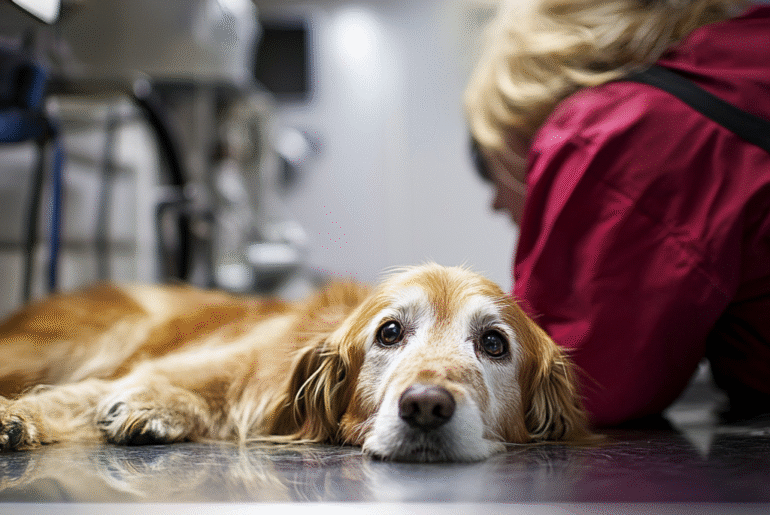This article may contain references to products or services from one or more of our advertisers or partners. We may receive compensation when you click on links to those products or services. Nonetheless, our opinions are our own.
The information presented in this article is accurate to the best of our knowledge at the time of publication. However, information is subject to change, and no guarantees are made about the continued accuracy or completeness of this content after its publication date.
Pet owners encounter the daily responsibilities of caring for their animals, managing both emotional attachment and financial obligations. However, when unexpected medical emergencies occur, many find themselves faced with difficult decisions. According to recent studies, nearly half of American pet owners have had to delay or deny critical veterinary care due to financial constraints.
This growing concern reflects a larger issue at the intersection of compassion and affordability in pet ownership. Knowing the causes of financial strain and how to prepare for them can help pet owners make informed decisions without compromising their pets’ well-being.
- The Rising Costs of Veterinary Care
- Exploring the Breakdown of Veterinary Costs
- How to Assess What Care Your Pet Really Needs
- Practical Budgeting Tips for Pet Health Expenses
- Affordable Alternatives for Veterinary Care
- Making Informed Decisions for Your Pet’s Well-Being
- Conclusion
- Frequently Asked Questions
- What is the primary reason many American pet owners are denying critical care for their pets?
- How does the financial burden of pet care affect decision-making?
- What are common treatments pet owners might skip due to cost?
- How do owners typically feel about these difficult choices?
- Are resources available to help?
- What preventive steps can help avoid these situations?
- Recommended Reads
The Rising Costs of Veterinary Care
Veterinary care has become increasingly expensive, placing immense pressure on household budgets. While routine check-ups are necessary, it is often the unexpected medical emergencies that present the greatest financial challenges.
Common Veterinary Costs
| Service | Average Cost |
|---|---|
| Routine Check-up | $50–$150 |
| Vaccinations | $20–$100 |
| Emergency Surgery | $1,000–$3,000+ |
These costs can quickly add up, particularly when combined with rising living expenses, stagnant wages, and inflation. Frequently, pet owners find themselves wondering:
- How can I afford necessary treatment?
- Are there more cost-effective options?
- Is pet insurance a smart investment?
Being proactive with budgeting and understanding the financial demands of pet care is important.
Exploring the Breakdown of Veterinary Costs
The emotional bond between pets and their owners can be tested by steep medical bills. Annual visits, once affordable, now compete with rising costs in other areas of life.
Specific Cost Examples
| Vet Service | Average Cost ($) |
|---|---|
| Annual Wellness Exam | 200–400 |
| Emergency Visit | 800–1,500 |
| Dental Cleanings | 300–700 |
| Specialist Consultation | 150–300 |
Specialty services such as oncology or cardiology can exceed $5,000. These figures highlight the importance of budgeting and understanding available options before a crisis occurs.
How to Assess What Care Your Pet Really Needs
To make smart decisions, pet owners should evaluate their pet’s specific needs based on age, breed, and health history.
Factors to Consider
- Routine Veterinary Visits: Regular exams prevent more serious (and expensive) problems later.
- Preventive Care: Vaccinations, flea and tick prevention, and dental hygiene can save future costs.
- Chronic Conditions: Pets with preexisting issues may require specialized, long-term care.
Pet Needs
| Pet Age | Typical Needs | Potential Costs |
|---|---|---|
| Puppy | Vaccinations, Training, Nutrition | $$ |
| Adult | Routine Check-ups, Preventive Meds | $$$ |
| Senior | Specialized Care, Frequent Vet Visits | $$$$ |
By tailoring care based on need, owners can prioritize expenses more effectively.
Voted "Best Overall Budgeting App" by Forbes and WSJ
Monarch Money helps you budget, track spending, set goals, and plan your financial future—all in one app.
Get 50% OFF your first year with code MONARCHVIP
Practical Budgeting Tips for Pet Health Expenses
Pet healthcare shouldn’t be an afterthought. A clear, structured plan allows owners to manage costs efficiently.
Budgeting Strategies
- Emergency Fund: Save monthly for emergencies even $10 to $50 per month adds up.
- Research Local Vets: Compare prices for services like dental work, spaying, or vaccinations.
- Consider Pet Insurance: A monthly premium may offer peace of mind during medical emergencies.
- Payment Plans: Ask your vet about installment options.
- Routine Check-ups: Catching issues early can prevent larger expenses.
Yearly Expense Estimates
| Expense Category | Estimated Annual Cost |
|---|---|
| Routine Vet Visits | $200–$500 |
| Emergency Care | $800–$2,500 |
| Medications | $100–$400 |
| Food & Supplies | $300–$600 |
| Grooming | $200–$400 |
Tracking expenses can help maintain financial control while providing high-quality care.
Affordable Alternatives for Veterinary Care
When traditional care becomes too expensive, explore alternative options that can still provide support without overwhelming costs.
Cost-Saving Options
- Pet Insurance: May cover up to 90% of major procedures.
- Payment Plans: Offered by many clinics to reduce upfront burden.
- Community Resources: Nonprofits and local shelters may offer discounted services.
- Telehealth: Remote consultations are cheaper and faster for non-urgent cases.
Monthly Cost Comparison
| Option | Estimated Monthly Cost | Potential Savings |
|---|---|---|
| Pet Insurance | $30–$70 | Up to 90% on major procedures |
| Payment Plans | Varies | Spreads costs and reduces financial stress |
| Community Resources | Free/Low Cost | Hundreds in potential savings |
| Telehealth | $15–$50 | Saves time and travel costs |
Being informed about these options can offer peace of mind and financial flexibility.
Making Informed Decisions for Your Pet’s Well-Being
Facing financial barriers doesn’t mean you must sacrifice your pet’s health. With the right approach, pet care and financial security can coexist.
Recommended Actions
- Set a Pet Budget: Allocate monthly funds for care needs.
- Explore Pet Insurance: Review providers and coverage options.
- Pursue Preventive Care: Stop small problems from becoming costly ones.
- Build an Emergency Fund: Prepare now for future needs.
Cost Comparison Table
| Care Option | Estimated Cost | Pros | Cons |
|---|---|---|---|
| Routine Vet Checkups | $50–$200 | Prevents illness | Cumulative annual cost |
| Pet Insurance | $20–$100/month | Reduces out-of-pocket expenses | May not cover all procedures |
| Emergency Fund Savings | Varies | Readily available | Requires discipline to maintain |
With preparation and foresight, pet owners can make financially sustainable decisions that protect both their loved ones and their wallets.
Conclusion
The bond between pets and their owners is one of unconditional love, but that love is increasingly tested by the financial realities of modern veterinary care. With costs rising across the board, it’s vital that pet owners take a proactive, informed approach. Budgeting, insurance, emergency planning, and awareness of affordable care alternatives are key to ensuring pets receive the care they need without placing undue strain on household finances.
By understanding the true costs, assessing care needs early, and utilizing all available resources, pet owners can continue to offer their furry companions the happy, healthy lives they deserve without facing impossible decisions.
Frequently Asked Questions
What is the primary reason many American pet owners are denying critical care for their pets?
The primary reason is the rising cost of veterinary care. Many owners must prioritize basic household expenses over expensive treatments.
How does the financial burden of pet care affect decision-making?
It forces owners to choose between financial stability and their pet’s health, often leading to feelings of guilt and helplessness.
What are common treatments pet owners might skip due to cost?
Emergency surgeries, diagnostic imaging, medications for chronic conditions, and specialty treatments are often skipped due to expense.
How do owners typically feel about these difficult choices?
Many report deep sadness, guilt, and frustration over not being able to afford the care their pets need.
Are resources available to help?
Yes. Options include nonprofit assistance programs, payment plans, sliding-scale veterinary services, and pet insurance.
What preventive steps can help avoid these situations?
Regular checkups, vaccinations, budgeting, and breed-specific health research can reduce long-term expenses and health risks.

Reviewed and edited by Albert Fang.
See a typo or want to suggest an edit/revision to the content? Use the contact us form to provide feedback.
At FangWallet, we value editorial integrity and open collaboration in curating quality content for readers to enjoy. Much appreciated for the assist.
Did you like our article and find it insightful? We encourage sharing the article link with family and friends to benefit as well - better yet, sharing on social media. Thank you for the support! 🍉
Article Title: Vet Costs Rising: Why 50% of Pet Owners Skip Critical Care
https://fangwallet.com/2025/06/01/pet-owners-skip-critical-care/The FangWallet Promise
FangWallet is an editorially independent resource - founded on breaking down challenging financial concepts for anyone to understand since 2014. While we adhere to editorial integrity, note that this post may contain references to products from our partners.
The FangWallet promise is always to have your best interest in mind and be transparent and honest about the financial picture.
Become an Insider

Subscribe to get a free daily budget planner printable to help get your money on track!
Make passive money the right way. No spam.
Editorial Disclaimer: The editorial content on this page is not provided by any of the companies mentioned. The opinions expressed here are the author's alone.
The content of this website is for informational purposes only and does not represent investment advice, or an offer or solicitation to buy or sell any security, investment, or product. Investors are encouraged to do their own due diligence, and, if necessary, consult professional advising before making any investment decisions. Investing involves a high degree of risk, and financial losses may occur including the potential loss of principal.
Source Citation References:
+ Inspo
There are no additional citations or references to note for this article at this time.












































